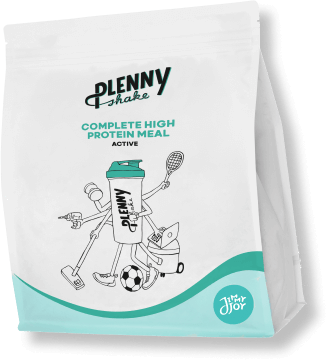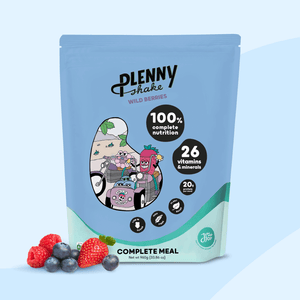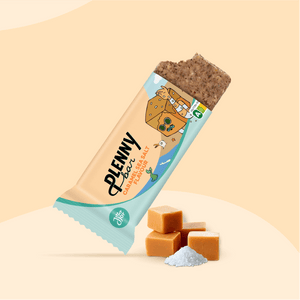Plenny Drink V2.0 is a source of fiber, high in protein, and low in sugar and salt. Want to find out more about the changes we made to the formula? This blog will tell you all about it!
TL;DR:
- Increased protein content from 12g per meal to 20g per meal
- Decreased carb content from 53g to 44,6 per 100g
- Improved flavor and consistency
- Improved macro and micronutrient profile

Increased protein content
Protein is a nutrient we simply cannot go without, being building-blocks for compounds in your body such as enzymes and hormones (1,2). Plenny Drink V1.0 got you covered for the essentials by providing you with 12 grams of protein per meal. The 20 grams of protein per meal that Plenny Drink V2,0 contains makes sure you get some extra to make you feel more satiated throughout the day and to help you recover after a heavy workout and to get those muscles growing (3,4)!
Adjusted carbohydrate composition
Quality over quantity is a statement we truly believe in considering the carbohydrate content of our products. That is why the carbohydrates content is decreased from 53 gram to 44,6 grams. But no worries! This is enough to provide the energy your body and brain need (5,6). Also, the quality of the carbohydrate sources is upgraded by adding healthier, complex and slow-releasing ones: The oat content is increased and the Plenny Drink is enriched with tapioca starch, which can lower the glycemic load of the products resulting in fewer spikes in your blood sugar (7,8). We take no further responsibility for any after-dinner naps you may take! A complete guide for preventing food coma can be found here.
Per 400 kcal meal (330ml)
| Plenny Drink |
v1.0 |
v2.0 |
|
Energy |
400 kcal |
401 kcal |
|
Fats |
14.4 g |
14.5 g |
|
From which saturates |
1.0 |
1.0 |
|
Omega 3 Omega 6 |
0.8 g 2.2 g |
0.8 g 2.2 g |
|
Carbohydrates |
53 g |
44.6 g |
|
From which sugars |
6.9 g |
6.9 g |
|
Fiber |
5.9 g |
5.9 g |
|
Protein |
12 g |
20.0 g |
|
Salt |
0.5 g |
0.5 g |
Besides the macronutrients, we also dug a little deeper into improving the micronutrient content.
Improved vitamin content
Vitamin D is a nutrient having a great influence on your immune system, but also on calcium absorption and even your mood (9,10). This is why the content of this nutrient is increased to 3 μg per meal in the form of cholecalciferol, contributing to 60% of the RDI. Getting more interested in how nutrients influence your mood? Read this blog to find out more!
Vitamin C has an important role in your body, being involved in e.g. the absorption of iron, and a well-nourished immune system (11). Besides this, vitamin C functions as an antioxidant, protecting your body’s cells from free-radicals. Reason enough to replenish this nutrient, right?
Vitamin K contributes to the bone metabolism, produces various proteins necessary for blood clotting and helps your body regulate blood calcium levels (12–14). Plenny Drink V2.0 provides you with a slight increase and the most bioavailable form of this Vitamin, being K2 MK7, also known as menachinon (15).
Another vitamin functioning as an antioxidant is Niacin. Besides protecting your cells from free-radicals, it is also part of coenzymes that give energy to your brain and plays a role in DNA repair, a process in which Folic acid also participates (16–19). In addition, it breaks down excessive amounts of the amino acid homocysteine, for which we found essential to slightly increase the amounts of these two micronutrients while still reaching their respective daily recommended intake levels (18,19).
Another nutrient increased, quite drastically, is Vitamin B12. The RDI one meal of Plenny Drink has been increased from 20% to 1120%. No, we’re not going crazy. Our chosen source for this is vegan cyanocobalamin. Vegan forms of B12 are less bioavailable, so more needs to be consumed to absorb the recommended intakes (20). More information about the reasoning behind this can be found in this blogpost.
Improved mineral and trace-element composition
To stay as close as possible from the Daily Recommended Intakes established for Iron and Calcium, and the latest adequate intakes (AI) and population reference intakes (PRI) defined by EFSA, we gave these minerals a slight increase in comparison to our previous version of the Plenny Drink (21–23). Gotta keep up the rhythm of science, right? And you should as well! For your reference: the PRI is the intake of a nutrient that is likely to meet the needs of almost all healthy people in a population, and the AI is the average nutrient level, based on observations or experiments, that is assumed to be adequate for the population's needs (23). Depending on the available information and studies performed globally, the recommended levels for each micronutrient are determined by EFSA.
Phosphorus is a mineral your body needs to keep the bones strong, remove waste and repair damaged body tissues (24). This mineral is as essential for the body as it is for the consistency of the vitamin and mineral mix we add to the Plenny Drink. Thanks to its technical properties, some minerals are premixed with Phosphorus to allow their correct addition. As a result, higher amounts of this mineral are present, in comparison to the RI. These amounts are compensated by using a form that is absorbed to a lesser extent, yet still meets the daily recommended intake values.
Molybdenum helps your body with building enzymes (25,26). To stay updated with the recommended intake values established for these compounds, the amounts are found slightly increased in our new Plenny Drink version. Curious to learn more about the functions all micronutrients carry out in your body? Check out our Introduction to micronutrients.
Fluoride has been removed from the Plenny Drink. Fluoride has the role to prevent caries in your teeth (27,28). Nevertheless, brushing your teeth with a fluoride-containing toothpaste is the most effective method to fight this sufficiently (28). This is why we just strongly recommend you to do so! Yep, one of the few things the Plenny Drink cannot help you with!
Per meal (330 ml)
|
v1.0 |
v2.0 |
|
|
Vitamin A |
160 µg |
160 µg |
|
Vitamin D |
1.0 µg |
3.0 µg |
|
Vitamin E |
2.4 mg |
2.4 mg |
|
Vitamin K |
15 µg |
16 µg |
|
Vitamin C |
16 mg |
40 mg |
|
Thiamin |
0.2 mg |
0.2 mg |
|
Riboflavin |
0.3 mg |
0.3 mg |
|
Niacin |
3.2 mg |
3.6 mg |
|
Vitamin B6 |
0.3 mg |
0.3 mg |
|
Folic Acid |
40 µg |
60 µg |
|
Vitamin B12 |
0.5 µg |
28 µg |
|
Biotin |
10 µg |
10 µg |
|
Pantothenic acid |
1.2 mg |
1.2 mg |
|
Potassium |
400 mg |
400 mg |
|
Chloride |
160 mg |
160 mg |
|
Calcium |
160 mg |
185 mg |
|
Phosphorus |
165 mg |
140 mg |
|
Magnesium |
75 mg |
75 mg |
|
Iron |
2.8 mg |
3.2 mg |
|
Zinc |
2.0 mg |
2.0 mg |
|
Copper |
0.2 mg |
0.2 mg |
|
Manganese |
0.4 mg |
0.4 mg |
|
Fluoride |
0.4 mg |
0 mg |
|
Selenium |
11 µg |
11µg |
|
Chromium |
8 µg |
8 µg |
|
Molybdenum |
10 µg |
13 µg |
|
Iodide |
30 µg |
30 µg |
Can’t wait to benefit from these great improvements? Place your order here!
Sources
- WHO | Protein and amino acid requirements in human nutrition [Internet]. WHO. World Health Organization; [cited 2020 Apr 7]. Available from: http://www.who.int/nutrition/publications/nutrientrequirements/WHO_TRS_935/en/
- Pendick D. How much protein do you need every day? [Internet]. Harvard Health Blog. 2015 [cited 2020 Apr 9]. Available from: https://www.health.harvard.edu/blog/how-much-protein-do-you-need-every-day-201506188096
- Blom WAM, Lluch A, Stafleu A, Vinoy S, Holst JJ, Schaafsma G, et al. Effect of a high-protein breakfast on the postprandial ghrelin response. Am J Clin Nutr. 2006 Feb;83(2):211–20.
- Batterham RL, Heffron H, Kapoor S, Chivers JE, Chandarana K, Herzog H, et al. Critical role for peptide YY in protein-mediated satiation and body-weight regulation. Cell Metab. 2006 Sep;4(3):223–33.
- Slavin J, Carlson J. Carbohydrates1. Adv Nutr. 2014 Nov 3;5(6):760–1.
- Medicine I of. Dietary Reference Intakes for Energy, Carbohydrate, Fiber, Fat, Fatty Acids, Cholesterol, Protein, and Amino Acids [Internet]. 2002 [cited 2020 Apr 9]. Available from: https://www.nap.edu/catalog/10490/dietary-reference-intakes-for-energy-carbohy drate-fiber-fat-fatty-acids-cholesterol-protein-and-amino-acids
- Ask the Expert: Legumes and Resistant Starch [Internet]. The Nutrition Source. 2015 [cited 2020 Apr 9]. Available from: https://www.hsph.harvard.edu/nutritionsource/2015/11/16/ask-the-expert-legumes-and-resistant-starch/
- Oats | The Nutrition Source | Harvard T.H. Chan School of Public Health [Internet]. [cited 2020 Apr 9]. Available from: https://www.hsph.harvard.edu/nutritionsource/food-features/oats/
- Aranow C. Vitamin D and the Immune System. J Investig Med Off Publ Am Fed Clin Res. 2011 Aug;59(6):881–6.
- Boston 677 Huntington Avenue, Ma 02115 +1495‑1000. Vitamin D [Internet]. The Nutrition Source. 2012 [cited 2020 Mar 23]. Available from: https://www.hsph.harvard.edu/nutritionsource/vitamin-d/
- Boston 677 Huntington Avenue, Ma 02115 +1495‑1000. Vitamin C [Internet]. The Nutrition Source. 2012 [cited 2020 Mar 23]. Available from: https://www.hsph.harvard.edu/nutritionsource/vitamin-c/
- Boston 677 Huntington Avenue, Ma 02115 +1495‑1000. Vitamin E [Internet]. The Nutrition Source. 2012 [cited 2020 Apr 18]. Available from: https://www.hsph.harvard.edu/nutritionsource/vitamin-e/
- Boston 677 Huntington Avenue, Ma 02115 +1495‑1000. Vitamin K [Internet]. The Nutrition Source. 2012 [cited 2020 Apr 18]. Available from: https://www.hsph.harvard.edu/nutritionsource/vitamin-k/
- Vitamin K: Uses, Deficiency, Dosage, Food Sources, and More [Internet]. [cited 2020 Apr 18]. Available from: https://www.webmd.com/vitamins-and-supplements/supplement-guide-vitamin-k#
- Vitamin K: Health benefits, daily intake, and sources [Internet]. [cited 2020 Apr 22]. Available from: https://www.medicalnewstoday.com/articles/219867
- Sato T, Schurgers LJ, Uenishi K. Comparison of menaquinone-4 and menaquinone-7 bioavailability in healthy women. Nutr J. 2012 Nov 12;11:93.
- Niacin (Vitamin B3) [Internet]. WebMD. [cited 2020 Apr 18]. Available from: https://www.webmd.com/diet/supplement-guide-niacin
- Office of Dietary Supplements - Niacin [Internet]. [cited 2020 Apr 18]. Available from: https://ods.od.nih.gov/factsheets/Niacin-HealthProfessional/
- Folic Acid: Uses, Side Effects, Interactions, Dosage, and Warning [Internet]. [cited 2020 Apr 18]. Available from: https://www.webmd.com/vitamins/ai/ingredientmono-1017/folic-acid
- Folate (Folic Acid) – Vitamin B9 | The Nutrition Source | Harvard T.H. Chan School of Public Health [Internet]. [cited 2020 Apr 18]. Available from: https://www.hsph.harvard.edu/nutritionsource/folic-acid/
- Watanabe F. Vitamin B12 sources and bioavailability. Exp Biol Med Maywood NJ. 2007 Nov;232(10):1266–74.
- Dietary reference values for potassium - - 2016 - EFSA Journal - Wiley Online Library [Internet]. [cited 2020 Apr 22]. Available from: https://efsa.onlinelibrary.wiley.com/doi/10.2903/j.efsa.2016.4592
- Scientific Opinion on Dietary Reference Values for iron. EFSA J. 2015;13(10):4254.
- Scientific Opinion on Dietary Reference Values for calcium. EFSA J. 2015;13(5):4101.
- Dietary reference values [Internet]. European Food Safety Authority. [cited 2020 Apr 22]. Available from: https://www.efsa.europa.eu/en/topics/topic/dietary-reference-values
- Publishing HH. Listing of vitamins [Internet]. Harvard Health. [cited 2020 Apr 22]. Available from: https://www.health.harvard.edu/staying-healthy/listing_of_vitamins
- Copper: Health benefits, recommended intake, sources, and risks [Internet]. [cited 2020 Apr 18]. Available from: https://www.medicalnewstoday.com/articles/288165
- Copper and Your Health [Internet]. WebMD. [cited 2020 Apr 18]. Available from: https://www.webmd.com/vitamins-and-supplements/copper-your-health
- Turnlund JR, Keyes WR, Peiffer GL. Molybdenum absorption, excretion, and retention studied with stable isotopes in young men at five intakes of dietary molybdenum. Am J Clin Nutr. 1995 Oct;62(4):790–6.
- Molybdenum: Uses, Side Effects, Interactions, Dosage, and Warning [Internet]. [cited 2020 Apr 18]. Available from: https://www.webmd.com/vitamins/ai/ingredientmono-1249/molybdenum
- Manganese: Uses, Side Effects, Interactions, Dosage, and Warning [Internet]. [cited 2020 Apr 22]. Available from: https://www.webmd.com/vitamins/ai/ingredientmono-182/manganese
- Fluoride [Internet]. Linus Pauling Institute. 2014 [cited 2020 Apr 15]. Available from: https://lpi.oregonstate.edu/mic/minerals/fluoride
- König KG, Berendsen CMM, Fokker AM, van Geest JTh, Kalsbeek H, Loveren C van, Weijden GA van der: Efficiënte preventie. Slotartikel Nederlands Tijdschrift voor Tandheelkunde 1994;101:213-219
 Everything You Need In One Meal
Everything You Need In One Meal
 Stay Full For 3-5 Hours
Stay Full For 3-5 Hours













 Product added to cart
Product added to cart





